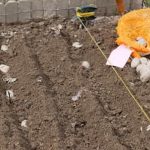Are you interested in starting your own square foot garden? Do you want to make the most out of your limited gardening space? When it comes to square foot gardening, proper vegetable plant spacing is crucial for a successful and bountiful harvest. In this article, we will explore the ins and outs of vegetable plant spacing in square foot gardening, from understanding the concept to choosing the right vegetables and avoiding common mistakes.
Square foot gardening is a popular and efficient method of growing vegetables in small spaces. This technique involves creating a grid of one-foot squares and planting different varieties of vegetables in each section. This method not only maximizes space but also promotes better organization and easier maintenance. Proper plant spacing is essential to ensure that each plant has enough space to grow without competing for resources.
When it comes to square foot gardening, understanding the benefits of vegetable plant spacing is key. From maximizing yield to minimizing weeds and pests, there are numerous advantages to maintaining the correct distance between plants. Moreover, choosing the right vegetables for this type of gardening can make a significant difference in the overall success of your garden. In the following sections, we will delve into vegetable selection and specific plant spacing recommendations for various crops.
Benefits of Vegetable Plant Spacing in Square Foot Gardening
When it comes to square foot gardening, the benefits of proper vegetable plant spacing cannot be overstated. This gardening method, popularized by Mel Bartholomew in the 1980s, involves dividing the garden bed into square foot sections and efficiently spacing out different types of vegetables within each square.
One of the key advantages of this approach is that it allows for high yields in a small space, making it an ideal option for those with limited garden space or who are looking to maximize their harvest.
Proper vegetable plant spacing in square foot gardening also helps to reduce the likelihood of plants competing for resources, such as water, nutrients, and sunlight. With each type of vegetable allotted a designated number of squares based on its mature size, there is less overcrowding and better airflow between plants. This can result in healthier plants that are less susceptible to disease and pests.
In addition to maximizing space and promoting plant health, square foot gardening with proper vegetable plant spacing also makes it easier for gardeners to manage their crops. By clearly delineating where each type of vegetable should be planted within the grid layout, it becomes simpler to keep track of what is growing where, which in turn can help with tasks such as watering, fertilizing, and harvest planning.
| Benefit | Explanation |
|---|---|
| Maximizing yield | Square foot gardening allows for high yields in a small space |
| Reduced competition | Proper plant spacing reduces plants from competing for resources |
| Improved manageability | Easier management of crops by clearly defining planting spaces |
Choosing the Right Vegetables for Square Foot Gardening
When it comes to square foot gardening, choosing the right vegetables is crucial for maximizing space and ensuring a successful harvest. Not all vegetables are suitable for this gardening method, so it’s important to select ones that are well-suited for growing in small, densely planted areas.
Consider Compact Varieties
Compact varieties of vegetables are ideal for square foot gardening because they take up less space and can be planted closer together. Look for dwarf or bush varieties of tomatoes, peppers, cucumbers, and squash, as well as compact varieties of leafy greens like lettuce and spinach.
Focus on High-Yield Crops
In square foot gardening, space is valuable, so it’s best to focus on high-yield crops that will produce a bountiful harvest in a small area. Vegetables like beans, peas, carrots, radishes, and herbs are great choices for square foot gardening because they produce a lot of food in a small space.
Avoid Spreading Plants
When choosing vegetables for square foot gardening, it’s important to avoid plants that spread out or vine extensively. These types of plants can quickly overtake the limited space in a square foot garden and may crowd out other crops. Instead, opt for vegetables that grow upwards or compactly to make the most of the available space.
By carefully selecting compact varieties, focusing on high-yield crops, and avoiding spreading plants when choosing vegetables for square foot gardening, you can set yourself up for a successful and productive growing season. With the right plant selection, you can make the most of your limited garden space while enjoying a bountiful harvest of fresh produce.
Understanding Plant Spacing for Different Vegetable Varieties
Plant spacing is a critical component of successful square foot gardening. Different vegetable varieties have specific requirements for how far apart they should be planted in order to thrive and produce a good yield. Understanding these spacing guidelines is essential for maximizing the efficiency and productivity of your square foot garden.
When planning the layout of your square foot garden, it’s important to take into account the mature size of each vegetable plant. Some plants, such as tomatoes and peppers, require more space to spread out, while others, like lettuce and radishes, can be planted closer together. Refer to planting guides or seed packets for specific recommendations on plant spacing for each type of vegetable.
One popular method for determining plant spacing in square foot gardening is the “square foot” technique, which divides the gardening area into one-foot squares and allocates specific numbers of plants per square. For example, larger plants like broccoli may only allow for one plant per square foot, while smaller plants like carrots can be grown in clusters within a single square.
This method helps ensure that each plant has enough space to access sunlight, nutrients, and water without competing with neighboring plants.
| Vegetable | Spacing (Inches) |
|---|---|
| Tomatoes | 24-36 |
| Lettuce | 4-12 |
| Carrots | 1-3 |
Tips for Maximizing Space in Square Foot Gardening
Square foot gardening is a popular and efficient way to grow a variety of vegetables in a small space. Maximizing the limited area requires careful planning and precise plant spacing. Here are some tips to make the most out of your square foot garden:
- Use companion planting: Pairing compatible plants together can help maximize space and promote healthy growth. For example, planting lettuce between rows of taller plants like tomatoes can utilize the space efficiently.
- Utilize vertical space: Certain vine varieties, such as cucumbers or pole beans, can be trained to grow vertically with the help of trellises or stakes. This allows you to save ground space for other vegetables.
- Succession planting: After harvesting early-season crops like radishes or lettuce, consider replanting the same space with a different vegetable variety. This continuous planting ensures that the garden remains productive throughout the growing season.
It’s important to note that proper plant spacing is crucial for the success of square foot gardening. Overcrowding can lead to competition for nutrients, water, and sunlight, resulting in stunted growth and lower yields. By following these tips and techniques for maximizing space, you can make the most out of your square foot garden and enjoy a bountiful harvest.
Remember to regularly monitor your garden’s growth and make necessary adjustments to ensure that each vegetable has enough space to thrive. With careful planning and attention to detail, your square foot garden can be highly productive and rewarding.
Importance of Proper Plant Spacing for Healthy Growth
Proper plant spacing is crucial for healthy growth in square foot gardening. When it comes to maximizing your garden space, it can be tempting to pack as many plants as possible into a small area. However, overcrowding can lead to competition for nutrients, sunlight, and water, resulting in stunted growth and decreased yield. By understanding the importance of proper plant spacing, you can ensure that your vegetables have enough room to thrive and produce an abundant harvest.
To achieve the best results in square foot gardening, it is essential to follow the recommended spacing guidelines for each vegetable variety. Different plants have varying space requirements based on their size, spread, and root systems. Creating a well-organized layout that takes these factors into consideration will contribute to healthier plants and higher productivity.
To help you visualize the correct plant spacing for your square foot garden, consider using a grid system that divides the growing area into equal squares. This method not only simplifies the process of arranging your plants but also ensures that each one has enough space to develop without interference from neighboring crops.
When planning your square foot garden layout, take into account the mature size of each vegetable plant as well as any specific requirements they may have. For example:
- Tomatoes: 1 plant per square foot
- Carrots: 16 plants per square foot
- Lettuce: 4 plants per square foot
Following these guidelines will promote healthy growth and allow for proper air circulation and sunlight exposure throughout your garden. With careful planning and attention to detail, you can create an efficient and productive square foot garden with optimal plant spacing.
Common Mistakes to Avoid When Plant Spacing in Square Foot Gardening
When it comes to square foot gardening, plant spacing is crucial for the success of your vegetable garden. However, there are some common mistakes that many gardeners make when it comes to plant spacing in this method of gardening. By being aware of these mistakes, you can ensure that your vegetables have enough space to grow and thrive.
Ignoring the Square Foot Grid
One common mistake in square foot gardening is ignoring the grid system that organizes the garden into square foot sections. Each square on the grid has a specific number of plants that can be grown within it, depending on the type of vegetable. Ignoring this grid and overcrowding plants within a single square can lead to competition for nutrients and limited growth potential for your vegetables.
Not Following Plant Spacing Recommendations
Another mistake is not following the recommended plant spacing for each type of vegetable. Different plants require different amounts of space to grow properly, and failing to adhere to these recommendations can result in stunted growth and decreased yields. It’s important to research and understand the specific plant spacing requirements for the vegetables you plan to grow in your square foot garden.
Underestimating Growth Potential
Many gardeners make the mistake of underestimating the growth potential of their vegetables when planning their square foot garden. It’s important to consider how large each plant will become at maturity and allocate sufficient space accordingly. Neglecting this factor can lead to overcrowding as the plants expand, ultimately impacting their ability to produce healthy crops.
By being mindful of these common mistakes, you can avoid them and ensure successful plant spacing in your square foot gardening endeavors. Taking the time to properly plan and organize your garden will result in healthier, more productive vegetables for you to enjoy.
Maintenance and Care for Vegetables in Square Foot Gardening
Once you have successfully set up your square foot garden and planted your vegetables at the recommended spacing, it is important to properly maintain and care for them to ensure a successful harvest. Regular maintenance includes watering, weeding, and proper nutrition for your plants.
Watering is crucial in square foot gardening, as the confined space means plants may compete for moisture. It is important to water deeply and regularly, especially during dry periods. Using a drip irrigation system or soaker hoses can help ensure that each plant receives the right amount of water without wasting it.
Weeding is also essential to maintain a healthy square foot garden. With the close planting of vegetables in this method, weeds can quickly take over and compete with the plants for nutrients. Regularly remove any weeds that sprout up in your garden to prevent them from overtaking your vegetable beds. Additionally, providing proper nutrition through organic fertilizers or compost will help ensure that your vegetables thrive in their limited space.
By properly maintaining and caring for your vegetables in square foot gardening, you can enjoy a bountiful harvest while maximizing the use of space in your garden. Remember that regular watering, weeding, and providing proper nutrition are key components of successful maintenance and care for vegetable plants in this gardening method.
Conclusion
In conclusion, proper vegetable plant spacing in square foot gardening is essential for the success and productivity of your garden. By following the principles of square foot gardening, you can maximize your space and ensure that each plant has enough room to grow and thrive. The benefits of this method include efficient use of space, reduced weeding and maintenance, and higher yields from your crops.
When choosing the right vegetables for square foot gardening, it’s important to consider their space requirements and how they will interact with other plants in close proximity. Understanding the specific plant spacing for different vegetable varieties will help you plan and layout your garden effectively. By following these guidelines, you can avoid overcrowding and competition for resources among your plants.
Maximizing space in square foot gardening requires careful planning and consideration of each plant’s needs. Whether you’re a beginner or experienced gardener, proper vegetable plant spacing is crucial for healthy growth and abundant harvests. With attention to detail, maintenance, and care, you can enjoy a successful square foot garden that provides a bountiful supply of fresh produce throughout the growing season.
Frequently Asked Questions
What Is the Spacing for Vegetables in a Square Foot Garden?
The spacing for vegetables in a square foot garden typically follows the concept of planting a certain number of plants per square foot. For example, larger plants like tomatoes may require one plant per square foot, while smaller plants like carrots may allow for 16 plants per square foot.
How Many Vegetables Can You Grow Per Square Foot?
The number of vegetables you can grow per square foot depends on the specific vegetable being grown and its recommended spacing. Generally, in a square foot garden, you can grow anywhere from 1 to 16 plants per square foot, depending on the size and spacing needs of each vegetable.
What Is the Best Row Spacing for a Vegetable Garden?
The best row spacing for a vegetable garden will vary depending on the types of vegetables being grown. Some crops may require wider row spacing to accommodate their growth and harvesting needs, while others can be planted closer together in narrower rows.
It’s important to consider the mature size of the vegetables and their sunlight needs when determining row spacing for a vegetable garden.

If you’re looking to get into vegetable gardening, or are just looking for some tips on how to make your current garden better, then you’ve come to the right place! My name is Ethel and I have been gardening for years. In this blog, I’m going to share with you some of my best tips on how to create a successful vegetable garden.





